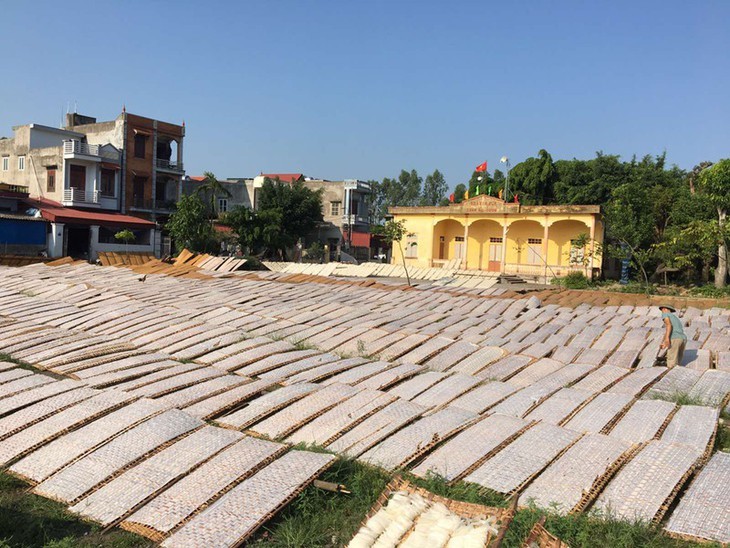 |
|
|
Rice noodle makers in Lo Cuong begin a new, busy day at 4 a.m. The village is echoed with the sound of flour mills, rice sheet dryers and cutting machines as villagers talk and laugh loudly, and walk with rapid steps.
Rice is soaked 2 hours before it’s milled into soft flour which will then be steamed by a machine. The final step is to dry the rice sheets on bamboo wattles. After being dried, the rice sheets are taken down and cut into small strings.
Pham Thi Trien’s family is one of the households in Lo Cuong hamlet A to produce rice noodles by a closed assembly line. With a closed system ranging from flour mills to rice sheet dryers and a 17-shelf drying machine, Trien’s facility regularly produces up to 3 tons of rice noodles.
“In the past, all production steps were done manually. Two years ago, we began to use the closed production line. Traders come directly to my house to receive the products which will then be distributed to smaller shops. We used to sell only to the locals but now our market has been expanded to the southern region,” said Trien.
140 households in Tu Minh ward are engaged in dried rice noodle production. In addition to about 10 establishments investing in the closed assembly line, the remaining families still follow the semi-manual method. In this method, after milling and steaming the rice sheets by machine, the sheets will be dried under the sun and then cut manually.
But no matter how it is produced, Lo Cuong rice noodles are well known for their delicious, thin, soft, and transparent strings.
Vu Thi Xuy of Lo Cuong hamlet A told VOV the secret to making their widely renowned noodles “The dough should always be soft and sticky so that it can turn out delicious noodles. When steaming the rice sheets, the kiln must be very hot so that the finished product can be even and soft.”
In 2006, Lo Cuong was recognized as a traditional craft village. Last year, the Hai Duong provincial Department of Science and Technology established a collective brand for Lo Cuong rice noodles.
Like many other craft villages, Lo Cuong is being challenged by urbanization. The recognition of Hai Duong as a first-class city offers a good opportunity for it to develop, which also means stronger demands for preserving and developing its craft villages.
Phan Quy Thanh, Deputy Head of Hai Duong city’s Economy Division, said “The city will focus on commercial production and services. Each year, we cooperate with the Bank for Social Policies to provide between 13,000 USD and 22,000 USD in loans for households to develop rice noodle production and carpentry. Attention has been paid to the construction of infrastructure and treatment of environmental pollution in craft villages.”
Nguyen Thi Viet Nga, Director of the provincial Department of Culture, Sports, and Tourism, said that in the years to come, Hai Duong will develop tours to Lo Cuong rice noodle craft village in which visitors can have hands-on experience from making traditional noodles.
She said “Hai Duong has many traditional craft villages but what we want now is to combine craft preservation with tourism development. To become a tourist destination requires close coordination among the Department of Culture, Sports and Tourism, the municipal People’s Committee, and the Department of Industry and Trade. Once tours of craft villages are opened, they will attract visitors and promote product brands.”
The tradition of making rice noodles in Lo Cuong village dates back to the 1960s and grew strong in the 1990s. VOV